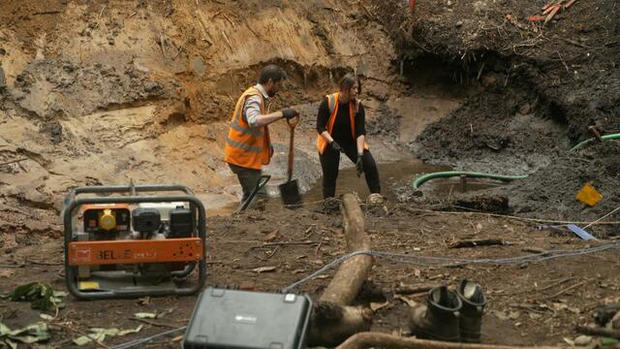
In 1944, a U.S. WWII pilot crashed in England during a secret mission. A search for his remains has revealed new clues.
Metal detectors beeped across a quiet, five-acre plot of forest and field on England’s eastern Suffolk coast as dozens of American and British service members sifted clumpy, wet soil from a deep impact crater. The tiniest of remains of U.S. Air Force pilot Lt. John Fisher might be here. Exactly 80 years ago Sunday – August 4, 1944 – his B-17 bomber crashed while on a secret mission targeting Nazi rocket sites in Europe during World War II.
“It can make you feel emotional, you know? They’ve found some personal artifacts that are very endearing,” said Garret Browning, a U.S. air repair specialist from Colorado with the U.S. 100th Maintenance Squadron, currently stationed in England.
Experienced in crash damage recovery, Browning is one of about 150 American and British active duty and retired military volunteers looking for a fallen fellow soldier. At 26 years old, Browning is already older than the pilot he was looking for.
Cotswold Archaeology, which oversees the cleaning, sorting and cataloguing of every remnant unearthed. Price is standing in the 10-foot deep crater, in thick, muddy water nearly up to her knees.
There is excitement with every new find, she says, with daily flybys overhead by pilots wishing them well and in respect to Lt. Fisher. But there is also a grounding, Price adds. She knows the work here can impact families by “doing something that brings tangible closure and peace to people who are living today, who remember the person that you’re recovering.”
Any possible remains found will be flown on a U.S Air Force plane to a Defense Department lab in Hawaii, she says, with tests run by the Defense POW/MIA Accounting Agency, or DPAA, which recovers lost U.S. service members from past wars. The DPAA will first confirm if remains are human, then try to match DNA to family. If successful, a full military burial is ordered.
“This really is the manifestation of ‘no man left behind,'” said Price, nodding to the so-called warrior ethos to bring home fallen soldiers. The DPAA estimates about 80,000 U.S. service members are still lost around the world with only about half considered recoverable.
CBS News
Price also says there’s a poignancy seeing U.S. and British military men and women sifting soil side by side – a symbol of the two countries’ enduring “special relationship,” a term coined by British Prime Minister Winston Churchill in the 1940’s as the U.S. helped Europe in the war.
“When you talk to local people, even today in their 80s, 90s, they remember the Americans coming,” said Price. “They still remember the excitement – how they watched those planes go out every morning. And they counted them back in the evening. And they were as bereft as anybody else when planes didn’t come back. And they were really grateful for the Americans coming over. And you still feel that.”
And work carries on, under this quiet canopy of trees on the English coast, to hopefully bring Lt. Fisher home.
Ramy Inocencio
Source: cbsnews.com
